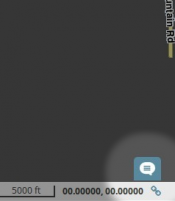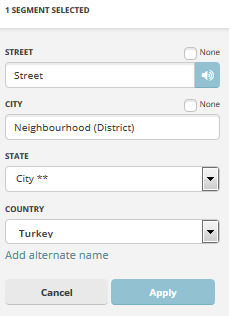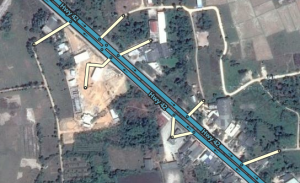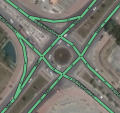You want to help too? Read along and join the Waze Turkey community.
What is Waze?
Waze is a free GPS navigation application for mobile telephone or tablet. Waze has speech support, free map updates and uses real time traffic information and actual reports from its users. Users like you! With Waze you can share your driver experience, connect with friends, send your ETA to show when you will be home, or just avoid traffic jams. Waze is crowd-sourced, meaning it is maintained by its users.
- Waze has the application, often called client or just app. You can read more about the app on the global wiki pages.
- There is a map, that is maintained by users, the Waze Map Editor (WME). Information on editing can be found in the paragraph about Editing.
- Its users form a community, who work together locally as well as internationally.
This page focuses on the community and Map Editing in Turkey. For the general basics on editing, there is a Guide provided. With these two pages, everyone should be able to edit constructively in Turkey! If you want to know more about a subject, there are many links provided to pages with detailed explanations. Our advice is to open them while you press Ctrl. This opens the linked pages in another tab and keep this basic page open. Anyway, without reading all the extra pages, you should be able to edit basically well too!
Community
The community maintains the Waze map and makes sure it works as best as possible. We make guidelines that are specific of our location, as well as work together internationally. The community of Turkey is not very large yet, and much of the map in Turkey is not maintained well. You can help by sharing your experiences, or even edit the map yourself. How to connect is described in Communication.
The current active community is a mix of Turkish and international editors. Please contact one of the CMs for further info.
| Community of Turkey | |||
|---|---|---|---|
| Editor | Area | Role | |
| CM | country | ||
Communication
How can I contact Waze? Where can I find more information? Where can I post my questions? Currently, the Country Managers (CM) are responsible for Waze in Turkey. Please contact them for questions or assistance.
Turkey has a page on Facebook. The page is used mainly to inform anyone who is interested.
Forum
The forum of your own country is a good starting point for finding more information. You can read the latest information, learn from questions of other editors or ask a question yourself. Login to the Turkish forum using your standard Waze login and password you use in the app and the editor. In the forum you can also make use of Private Messages (PM). This is a kind of inbox, like your e-mail. When you receive a PM, you will also receive a message to your regular e-mail to inform you of the new message. How you can handle your PM's is described here.
Chat

While you are editing, you can directly request help in WME chat. It shows you the level of the editor you are talking to. Please keep in mind that most editors are willing to help, but not all of them have the technical knowledge or editing experience to give you the best answer. Because the built-in chat does not always work as desired, we also have Google Hangouts© en Slack©. Most editors, especially the higher level ones, have an account on both Hangouts and Slack.
Google Hangouts
Waze Turkey is on Hangouts. To use Hangouts, you need a Google account. There is an extension in Chrome, an app for your smart phone or tablet, or you can use your browser. In Hangouts, you can chat in groups or privately. If you want to join Waze Turkey on Hangouts, send your gmail-address to one of the CMs.
Wiki
A lot of information is available in the Wiki. There are global pages with information applicable to all regions in the World. There are local pages as well. Turkey just started with this Wiki page. Because we have many tourists and other international editors helping update our maps, this page is available in English too. At the bottom of each Wiki page, the last update is shown. If this is more than half a year ago, please take into consideration that the information might be outdated.
Editing
As the community is starting to grow, we now start to provide some guidelines for editors. We all try to help each other and learn from each other. We hope to be able to help you too.
How to start
First of all, read the whole paragraph of this Wiki about editing in Turkey and make yourself acquainted with the basic editing technics described in the WME Quick-Start. Then, start improving your home area. You know best how to drive in your area. Ask the community on how things can be handled if Waze acts differently than you expect. If you are satisfied with your home area, check the connecting roads from your town to the nearest towns and, subsequently, to Major Highways and Freeways. This is also the moment to consider applying for Area Management.
Roads
Base Map Editing
At many places in Turkey, a basemap was imported while the Satellite View was not aligned well. Therefore, the roads are often out-of-line very much. Click on a picture to enlarge.
As from April 2015, Satellite View seems to be up-to-date mostly. You can check the GPS tracks if you are in doubt, but keep in mind that the GPS data is not always very well recorded, as the signal is not always strong enough. In addition, GPS traces only show when there is some recent amount of data.
- Base Map editing examples
-
-
-
-
-
If you start correcting the base map, try to re-align the roads as much as possible and avoid deleting segments. This will keep the data that is assigned to the area (saved with the segments) intact. To start re-aligning, find a spot where you have enough room to drag the junction nodes to the junction they probably belong to. Subsequently, align the roads itself to the areal view using the geometry nodes.

Also, the turns are often restricted (red arrows) with soft turn restrictions. These are the turns that are based on the driving activity and not yet confirmed by an editor. You can recognize these by the little question mark next to the turn. This would be alright if there is no editing activity, as soft turns adapt to the driving behavior. However, if Waze is not used intensively (like in many locations in Turkey yet), driving directions that people don’t use will be inhibited and become unroutable. If you start working on an area, make sure you have checked all the junctions. A handy tool to see quickly where all turns in your screen are restricted, is the keyboard shortcut ⇧ Shift+z.

Road division: The map is not ready to be KISSed, or simplified. Roads that are divided by a solid middle part, are better drawn as two one-way lanes at this moment to avoid confusion for and editing mistakes by new editors.

Micro-doglegs: We often use micro-doglegs to force a turn instruction instead of keep or exit. This involves carefully placing the node very close to the intersection to achieve the correct angle, so it will be necessary to zoom in to see them. If you make a change, be sure to leave them with the same angle.
| Remember, please avoid deleting segments on the map. Try to re-use them to preserve the traffic data as much as possible (see the motto and its description for editors) |
Road naming
In Turkey, the administration of the municipalities, cities, towns and districts is different than the Waze standard.

For the time being, use the fields as follows:
- Street: Street, Avenue, Boulevard etc. (Sokak, Bulvari, Cadde, Caddessi, etc.)1
- City: village, town or neighbourhood (Bucak, Köy, Mahalle1), if necessary we add the District to it (İlçe) - see example3
- State: City (Province)2
- Country: Country
1 Street names are abbreviated, to save space on screen
2 The administrative city in Turkey is the Province, not the town.
3 Concerning the picture: If you don't see "Neighbourhood (Ilçe)" in the city field, click on the picture to see the newest version.
We are depending on local editors for the naming of the roads. As far as we are aware, there are no allowed sources available that we could use as a reference for street names. If you don't know the name of the road, check the None box after the street name in the edit menu. Specific information for some road types are explained in the paragraph on road types.
Abbreviations
We use the Turkish national standards for abbreviations of the roads, according to TDK. Most used abbreviations for WME are:
| name | abbreviation |
|---|---|
| Sokak | Sok |
| Cadde | Cad |
| Kavsak | Kvş |
| Mahalle | Mah |
| Bulvar | Blv |
| Yolu | Yolu |
| Çevreyolu | Çvy |
Road categories
Roads in WME can be added as street segments or roundabout segments. We can assign a type to each segment in the menu left. We use Functional Classification to choose what kind of segment and road type to use, depending on its use and the needed routing instructions.
Road types
- The main roads in a district or town should at least be set to primary.
- If segments will be used for through-going traffic or for longer distances connecting districts or towns, they should at least be mH (minor Highway)
- Main interconnecting roads with fast traffic should be MH (major Highway)
Always make sure a road is at least connected to a same level of road type or higher. Thus, Waze should be able to route from primary to primary (or higher), from minor to minor (or higher), from major to major (or higher), and from Freeway to Freeway. Another way of explaining this, is that you should be able to continuously drive on the same type of segments for the routing engine to use that road type in the calculations.
This means we need to sometimes make small roads mH, for the possibility of calculating long distance routing. Please discuss with the local champs if anything is unclear.
Drivable segments

Freeways
- are motorways designed for high speed traffic, connected to other roads exclusively by ramps. All freeways in Turkey are toll roads and numbered O-x or O-xx, where x is the road number.

- If the road connects to the International E-road network in Europe, it is assigned an E-xx number as well.
- In the primary name of the road, only use the road number with normal dashes, like O-xx, no city name. If the road has an E-x number as well, use it in the main name, like "O-3 (E-80)" (see picture).
- All other names can be put as an alternate name. However, make sure not to change road names at intersections without consulting this page or a senior editor, for they affect the routing instructions.

Major Highways
- are express roads that are not freeways. In Turkey, most state roads are major highway; they always starts with D-xxx. Similar to freeways, there might be an E-x number assigned as well. The latest directory of motorways is from 2014.
- In rural areas, use the same naming convention as described for freeways. In urban areas, a street and city name may be added. Keep the road number in the primary name, followed by the street name like: "D-100 Atatürk Blv". Add the streetname alone as an alternate name as well.
Minor Highways
- are mostly maintained by local authorities. There is no standard for road naming. We use this road type for through-going traffic or for longer distances connecting cities or towns.
Ramps
- are entrance and exit roads to highways. This road type in Waze has special functions for routing. It will yield the instruction "take the exit". Only use it for connections to and from highways where "take the exit" is applicable. In many cases, especially in urban areas, often just a "keep right" or a "turn right" is more helpful. Then, use the same type of road as the incoming or outgoing road type with the appropriate corners at the intersection, depending on the instruction needed. See the explanation on Interchanges and other connecting segments for detailed information. In case of doubt, ask a local champ or send a message to the CM.

- Generally, a ramp does not get a street or city name. An exception is when additional info is appreciated for navigation. Then, the direction that is shown on the signage may be added in the streetname, like: "D-xxx (E-xx) / Place1 / Place2" (see example).
Other Streets
- Primary Roads are main roads in a district or town. If they are used for through going traffic on longer distances, they might be typed minor or major highway (see Road types). If in doubt, check with a local champ.
- Dirt roads are, contrary to what is seems like, only those roads that need a 4x4 to drive on. Non-paved roads that are drivable for normal cars (and there are many in Turkey) should be typed normal “street”.
- In Turkey, dirt roads are often applied for rivers when dried up. People use those to drive, so we need to map them. To enable dirt roads in routing, you need to specify that in the settings in the client.
- Parking Lot Roads (to be added)
- Private roads (to be added)
All other drivable roads should be set to Street.
Roundabouts
Roundabouts, rotaries, or traffic circles, are unique segments in the Waze routing engine. When a driver approaches a roundabout segment, a specific icon is displayed in the turn direction area of the display with a number corresponding to the exit count from the driver's entry into the roundabout. Manually creating a circular road will not tell Waze to navigate the area as a roundabout. A roundabout gives you instructions (US) like: "On the roundabout, take the 3rd exit" or, "On the roundabout, go left" depending on the way of drawing. A roundabout should be assigned the same road type of the highest classified, ongoing connected road.
However, be careful with roundabouts. In Turkey, many roundabouts should NOT be drawn as a roundabout, to avoid confusing instructions.

Always ask yourself, what kind of instruction will you hear or see in the app? Do that for every road into every direction. In the picture, if you are at segment 3, and want to go to segment 5, you would now get "On the roundabout, take the 2nd exit". That is not conform the actual situation for the driver, who just drives straight. In this case, a roundabout would thus yield confusing instructions.
Some alternative solutions for such junctions are the following:
-
Solution to the example
-
Simplified junction, for smaller roads. This still yields the right instructions
-
Looks like a roundabout, but acts like a normal junction.
-
Always make sure the corners yield the right instructions
Intersections that could cause confusion like described above, should be locked to level 3. If you have any doubt, please ask a senior editor or local champ for advise.
Non-drivable segments
to be added
Locking Standard
As the map of Turkey still needs a lot of improvement, we don't want to lock too much that could block starting editors. However, to ensure routing, especially over larger distances, we do use locks for some roads according to the table below. Roads that need more protection because of special situations (construction, complicated design, frequent editing errors) may be locked higher. Make sure to thoroughly check the routing in the live map, before you lock the roads.
| Road type | Lock level |
|---|---|
| Freeway | 5 |
| Ramp | 5 |
| Major Highway | 4 |
| Minor Highway | 3 |
| Primary Street | 2 |
| |-|-|-|-|-|-|-|-|-| Railroad |-|-|-|-|-|-|-|-|-| | 2 |
| • • • • Ferry • • • • | 5 |

Also, in urban areas that are mostly under construction, try to make stubs to the roads: making a short low-level segment for each exit that a low-level editor can attach to. If you need to edit a road above your lock level, ask an unlock or ask a higher level editor in one of the communication platforms to do the edit for you.
Speed Limits
Although speed limits are not a priority at this moment, they can be entered via WME. Standard speed limits in Turkey are:
| Road Type | default speed in km/h (kph) |
|---|---|
| Freeway | 120 |
| Rural road, double lane | 110 |
| Rural road, single two-way lane | 90 |
| Urban road | 50 |
(source: http://www.kgm.gov.tr/Sayfalar/KGM/SiteTr/Trafik/HizSinirlari.aspx)
Please be aware that areas or parts of roads can have different limits. If you are not known in the area, only add speed limits when there is a source that can verify the allowed speed, like recent streetview images in WME or a request from a user.
Update Requests (URs)
![]()
![]()
![]()
![]()
Many areas are still not maintained well, and we have very old Update Requests open. As the map currently is not in very good shape, the URs signals where we have to work. Also, it provides a possibility to get into contact with our users.
To answer the Update Requests, we have prepared some standard responses. The doc is linked in the Turkish Slack channel too, to easily find it back. If you do not speak Turkish, please use both the English and Turkish comment, and keep in mind that translations via a web service are often not very accurate. If people respond in Turkish, ask a Turkish speaking editor for help.
Here is a first guideline for response times, based on the current situation:
For recent URs (<1 month):
- Start with thanking the reporter for reporting the issue.
- If the report is clear and you can solve the issue directly, please do and explain to the reporter what you have done. The reporter receives a message of your comment, and will feel valued for his/her addition. In addition, other editors can learn from your solution and it can help solving other issues in the neighborhood. You can close the UR as solved (standard response).
- When the issue is not clear, ask the reporter politely for more information (standard response).
- If the reporter doesn´t respond to your question within 7 days, you may send a reminder message. It often happens the reporters do respond only after a reminder (standard response).
- When the reporter also does not respond to your reminder within another 2 weeks, you can close the UR as "Not identified", with a comment in the conversation why you closed it (standard response). Meanwhile, there is some time to improve the area, and for the mapupdates to come live.
For reports between 1 and 6 months old, use your best judgement as to how to handle them. You may follow the guidelines above, and use the standard response asking for more info, that includes an excuse for responding late. Again, always try to improve the area before closing the UR.
For older reports (half a year or more), our main focus is to inform the reporter that we are working on the map and they can help if they want (see default response for very old URs). Allow at least two weeks before closing. In addition, before you close the report, try to figure out what the problem was. Always improve the area before you close the UR. Use the "Closing an UR after no feedback" text from the [https://goo.gl/MW1Vo1 standard responses].
Elaborate information on URs can be read in the general Wiki page on Update Requests. Be aware, that if guidelines differ from what is written above, the Turkish guidelines precede.
Map Problems (MPs)
Problem reports are automatically generated reports, that appear in the Waze Map Editor as a colored balloon without a smiley face. Balloons with a smiley face are user reported Update Requests and are covered in the paragraph above.
 There are several kinds of MPs. In Base Map Areas you will find Missing road and Restricted turn might be allowed most often. Other kind of MPs are described in the Global Page on Map Problems. Try to solve the problem and close the MP as Solved. If you don´t know how to solve it, please discuss it with a local champ first before closing it as Not identified.
There are several kinds of MPs. In Base Map Areas you will find Missing road and Restricted turn might be allowed most often. Other kind of MPs are described in the Global Page on Map Problems. Try to solve the problem and close the MP as Solved. If you don´t know how to solve it, please discuss it with a local champ first before closing it as Not identified.








